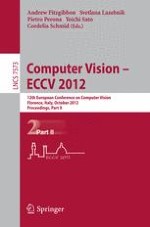2012 | OriginalPaper | Buchkapitel
Dynamic Eye Movement Datasets and Learnt Saliency Models for Visual Action Recognition
verfasst von : Stefan Mathe, Cristian Sminchisescu
Erschienen in: Computer Vision – ECCV 2012
Verlag: Springer Berlin Heidelberg
Aktivieren Sie unsere intelligente Suche, um passende Fachinhalte oder Patente zu finden.
Wählen Sie Textabschnitte aus um mit Künstlicher Intelligenz passenden Patente zu finden. powered by
Markieren Sie Textabschnitte, um KI-gestützt weitere passende Inhalte zu finden. powered by
Systems based on bag-of-words models operating on image features collected at maxima of sparse interest point operators have been extremely successful for both computer-based visual object and action recognition tasks. While the sparse, interest-point based approach to recognition is not inconsistent with visual processing in biological systems that operate in ”saccade and fixate” regimes, the knowledge, methodology, and emphasis in the human and the computer vision communities remains sharply distinct. Here, we make three contributions aiming to bridge this gap. First, we complement existing state-of-the art large-scale dynamic computer vision datasets like Hollywood-2[1] and UCF Sports[2] with human eye movements collected under the ecological constraints of the visual action recognition task. To our knowledge these are the first massive human eye tracking datasets of significant size to be collected for video (497,107 frames, each viewed by 16 subjects), unique in terms of their
(a) large scale and computer vision relevance, (b) dynamic, video stimuli, (c) task control, as opposed to free-viewing
. Second, we introduce novel
dynamic consistency and alignment models
, which underline the remarkable stability of patterns of visual search among subjects. Third, we leverage the massive amounts of collected data in order to pursue studies and build automatic, end-to-end trainable computer vision systems based on human eye movements. Our studies not only shed light on the differences between computer vision spatio-temporal interest point image sampling strategies and human fixations, as well as their impact for visual recognition performance, but also demonstrate that human fixations can be accurately predicted, and when used in an end-to-end
automatic
system, leveraging some of the most advanced computer vision practice, can lead to state of the art results.
